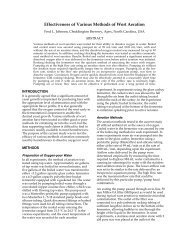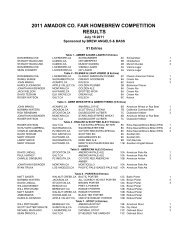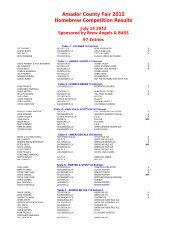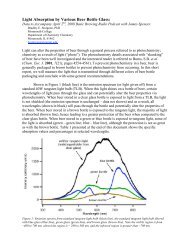A Homebrewer's Guide to Beer Flavor Descriptors - Brew Angels
A Homebrewer's Guide to Beer Flavor Descriptors - Brew Angels
A Homebrewer's Guide to Beer Flavor Descriptors - Brew Angels
You also want an ePaper? Increase the reach of your titles
YUMPU automatically turns print PDFs into web optimized ePapers that Google loves.
pression of what most would characterize as an offaroma<br />
or off‐flavor. It is often found <strong>to</strong> be one of the<br />
subtle components of what is referred <strong>to</strong> as<br />
“Hausgeschmack” or house character, in which<br />
case all products produced by a brewer will contain<br />
traces of the compound. This, in turn, indicates a<br />
consistency of source.<br />
The presence of this compound in beer can<br />
stem from two sources: bacterial infection of wort,<br />
and/or inefficient elimination or inadvertent entrainment<br />
of normally occurring DMS during beer<br />
processing.<br />
The major source of high levels of DMS is<br />
usually attributable <strong>to</strong> the presence of an infecting<br />
bacteria Obesumbacterium Proteus, commonly<br />
referred <strong>to</strong> as “wort bacteria.” This organism,<br />
which generates DMS as a metabolic byproduct, is<br />
sometimes found either in inadequately sanitized<br />
wort receivers or fermenters and associated transfer<br />
lines, pumps, sight glasses and CO₂ collection<br />
lines, or in trub mixed with, and infecting, coIlected<br />
yeast that is <strong>to</strong> be subsequently repitched.<br />
Prime conditions for the bacteria’s activity<br />
exist during the very earliest stages of fermentation<br />
where the pitched wort pH is greater than 4.5.<br />
Conditions such as low pitch rate or long yeast lagphase<br />
can allow substantial growth resulting in<br />
the development of significant amounts of DMS.<br />
The second likely source of DMS character in<br />
finished beer is related <strong>to</strong> process. DMS is normally<br />
found in the brewing process by virtue of the<br />
presence of its precurser, S‐methyl methionine, an<br />
amino acid type, in malt. S‐methyl methionine<br />
(SMM) is enzymatically formed in grain during the<br />
germination process.<br />
During kilning of green malt some SMM is hydrolyzed<br />
in<strong>to</strong> DMS (most of which is lost by evaporation)<br />
and homoserine (HS), an amino acid. A portion<br />
DMS is oxidized <strong>to</strong> dimethyl sulfoxide (DMSO).<br />
During the mashing process more SMM is hydrolyzed<br />
<strong>to</strong> DMS and HS with a small portion of DMS being<br />
oxidized <strong>to</strong> DMSO. During kettle boil the majority of<br />
DMS present plus most generated by continued<br />
SMM hydrolysis is lost due <strong>to</strong> evaporation. Again, a<br />
portion of residual DMS is oxidized <strong>to</strong> DMSO. In the<br />
fermentation stage DMSO is reduced <strong>to</strong> DMS by the<br />
yeast, and virtually all DMS, from both SMM<br />
hydrolysis and DMSO reduction, is purged from the<br />
fermenting beer by C0₂ evolution leaving only trace<br />
amounts generally below 50 ppb. In systems where<br />
CO₂ is collected for reuse <strong>to</strong> produce carbonation,<br />
and where CO₂ scrubbing and deodorizing systems<br />
are either inadequate or inefficient, CO₂‐borne DMS<br />
(and other volatiles) can be introduced in<strong>to</strong> what<br />
would otherwise be a very acceptable product.<br />
For the homebrewer, DMS can be avoided in a<br />
number of ways. First, clean and sanitize all brewing<br />
equipment thoroughly. Clean and sanitize any<br />
work areas that have received wort spillage. Boil<br />
wort for a minimum of one hour, especially if canned<br />
extracts are used. If one collects yeast for repitching<br />
and wishes <strong>to</strong> destroy any suspected bacteriological<br />
infection, one may elect <strong>to</strong> wash the yeast.<br />
Do this by reducing the pH of a magnetically<br />
stirred, ice‐water bath cooled beaker of yeast<br />
slurry <strong>to</strong> 2.2 with the dropwise addition of foodgrade<br />
concentrated phosphoric acid. (NOTE: This is<br />
a strong acid. Care in handling and use of proper<br />
personal protective equipment, including gloves,<br />
face shield and/or safety glasses is essential.)<br />
Maintain this pH for at least three hours but no<br />
more than four hours. Do this procedure immediately<br />
prior <strong>to</strong> pitching so that yeast viability is not<br />
impaired. The obvious alternative is <strong>to</strong> not use any<br />
yeast suspected <strong>to</strong> be bacteriologically infected.<br />
Reduce yeast lag times by premixing yeast<br />
with retained wort (try making a brew ahead of<br />
time and freezing the wort in one‐quart plastic<br />
containers) and thoroughly aerating one day in<br />
advance <strong>to</strong> bring the yeast <strong>to</strong> an active condition by<br />
pitching time. Remember that the earlier the<br />
fermenting wort pH drops below 4.5, the more<br />
protected it will be from the influence of wort<br />
bacteria, if present.<br />
Corrective and preventative treatment of CO₂<br />
scrubbing procedures are not discussed here because<br />
such activities are generally found only in<br />
commercial breweries and are beyond the scope of<br />
most homebrewing efforts.<br />
Fruity‐Estery<br />
By David Logsdon<br />
Esters formed in beer are aromatic compounds<br />
identified as fruity and estery at high levels. At lower<br />
levels, esters become part of the overall flavor<br />
SPECIAL ISSUE 1987 ZYMURGY 40






